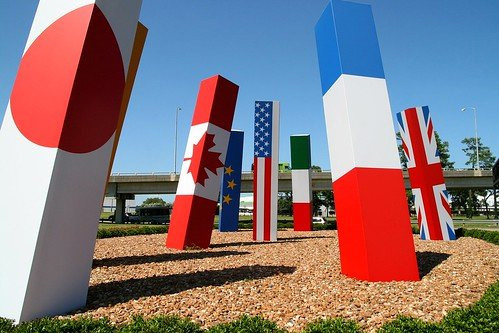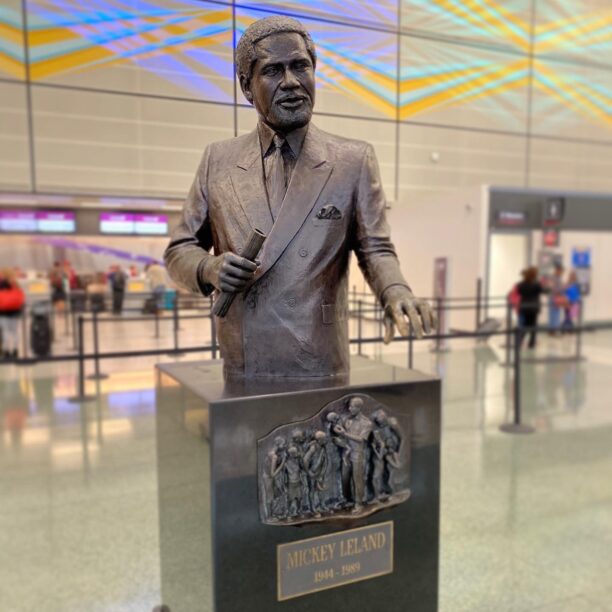Outside the George Bush Intercontinental Airport (IAH) in Houston, Texas, stand eight glowing spikes, each tilted at an angle of ten degrees, and each adorned with a different nation’s flag. The flag of the United States is in the center, and the others are planted at a distance commensurate with each country’s real distance from Houston; the sculpture, called “Light Spikes,” commemorates the Group of 7 meeting hosted here in 1990 by then-president George H.W. Bush. By the artist’s account, it represents “a diverse community coming together,” but from certain points of view, it appears that all the other flags are bowing to the United States.
There’s a description of the installation online, with a note that could serve as an unofficial motto for Houston: “View this artwork from your car, as there is no pedestrian access.”
 City of Houston Art Collection
City of Houston Art CollectionThe new airport, which replaced the smaller William P. Hobby airport south of the city, opened in June of 1969, just one month before man landed on the Moon. In the 1980s, the city council proposed naming the airport for Mickey Leland, an anti-poverty activist, five-term congressman, and Houston legend. Leland grew up in Fifth Ward, a historic majority-Black community, and attended Wheatley High School–as did Barbara Jordan, the first Black woman to represent Texas in Congress. After obtaining a degree in pharmacy from Texas Southern University, Leland returned to Fifth Ward and set up community health clinics for its poorest residents. After a stint in the State House, Leland ran for Jordan’s seat in the House of Representatives and won. In Congress, he pushed for a robust welfare state and protections for the unhoused, and led international aid efforts with Fidel Castro and Pope John Paul II.
To name Houston’s new international airport for Leland, arguably the city’s greatest and most selfless son, would be to give the world a piece of our history, to ceremoniously write the contributions of Houston’s Black community in the sky. Instead, he was pushed aside in favor of George H.W. Bush, the 41st President, who’d made the city his home in the 1950s and found fortune in the city’s booming oil industry. A starker contrast could scarcely be imagined. Leland’s father walked out on the family in 1947; Bush’s father, the Connecticut Senator Prescott Bush, gave his son a million dollars to start Zapata Petroleum, an offshore drilling company with CIA entanglements and alleged connections to both the 1954 Guatemalan Coup and the ill-fated Bay of Pigs invasion. In 1989, the year that Bush ascended to the Presidency, Leland died in a plane crash during a fact-finding mission to Ethiopia. Does Houston embody the spirit of Leland, who gave his life to the sick and poor? Or Bush, the deceptive face of “irreducible niceness” before whom lesser souls should bow?
I don’t travel much. Going to IAH is a treat for me, a place where I get to act like the grown-up version of myself. I grew up in College Station, an hour north of the airport. While my friends decided to go to far off schools and escape quiet suburbia, I went to college at home, to keep costs down, at a school where George H.W. Bush’s name adorns the school of government and international relations. I’m glad I did; I met my best friends and blossomed as a transgender woman. Still, I yearned to get out of my homophobic, racist state, to find a safe home for myself in blue America… and ended up in Houston.
 Bohao Zhao [CC BY 3.0] via Wikimedia Commons
Bohao Zhao [CC BY 3.0] via Wikimedia CommonsIAH looks like most major hub airports, with a Texas twist. Natural light streams in through soaring glass atriums that widen the space, introducing visitors to the illusion that everything really is bigger in Texas. My feet hurt, my neck hurts, and my head hurts trying to navigate the labyrinthine mishmash of terrazzo, glass and metal railing. Thankfully, there are two inter-terminal trains, one outside, and an underground subway that looks straight out of the backrooms, rumored to be a leftover Disney attraction. But I love taking the train at the airport, a luxury I don’t have in the city proper, where public transportation is sparse despite recent public investment.
Much of the art at IAH conveys a sense of what I can really only call “cowboy”, abstract metalworks conjuring the ideas of spurs and stirrups, barbed wire and ranchers and quick-draws (IAH is third in the nation for the most guns discovered in carry-on baggage). Light is a second major motif, from “Light Spikes” to the projected light murals in the arrivals terminal and the eerily glowing suitcases in baggage claim. The message is clear: you have reached the shining city on the hill, the beacon on the frontier that so enchanted Bush. There’s a life-size statue of him in Terminal C, frozen stoically in time with his sleeves rolled up and his jacket flung over his shoulder. But if you venture to Mickey Leland Terminal D, you’ll find a bust of Leland in marble and steel, buried from the waist down.

In 1979, Texas Monthly writer Richard West lived for three months in Fifth Ward. Forty years on, the journalistic style of “parachuting in” is no longer in favor, but West’s observations were sharp and deeply felt. In a National Magazine Award-winning essay, he would write of the resilience of “a community determined that life should win over death, hope over despair, pride over poverty,” as well as “the certainty that no life, no matter how virtuous, would escape the pain, misery, and degradation caused by poverty, racism, and prejudice.” All still true. Everyone remembers where they were when Hurricane Harvey devastated Houston, what they lost in the flood and what they found in its aftermath; everyone has a favorite hole-in-the-wall authentic Mexican joint; everyone has a vision of what Houston should look like, how to reckon with our history and how to shape what comes next. The trouble is that there are competing versions of this future, and they are irreconcilable.
The past lives uneasily with the present in this city. We drive on highways that were paved over communities built by emancipated slaves. New city centers pop up at the margins, ethnic enclaves bowing toward the middle, like the lighted pillars outside IAH. Old tile street signs peer up at me from the curb. Mid-century townhomes stand side by side with million-dollar condominiums, thanks to Houston’s lax zoning ordinances. In my neighborhood, whose congressional district gave George H.W. Bush his first job in politics, the white upper class walk their dogs while undocumented kids sleep on the curb. Nigerian all-night buffets share space with strip clubs and high-end furniture stores. I’ve found the first queer community I’ve ever had in my life, and it wasn’t in blue America; it was here.
But I know that someday I’ll likely have to leave Texas. Sometimes home can break your heart. The state government has set its sights on the LGBTQ+ community, pushing bans on everything from drag shows to library books and gender-affirming care. The state recently took over the Houston Independent School District, threatening to close Mickey Leland’s Wheatley High School and open charter schools in its place.
It’s hard to love a home that doesn’t love you back. One day maybe I’ll take off for the last time, either by choice or as a refugee, making a choice others won’t have. Until then, I’m getting to the airport early, so I can see the cowboy hat stores and CBD shops, and have my tacos with a tall glass of Shiner.






